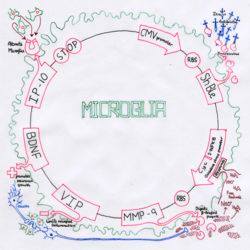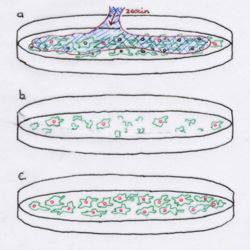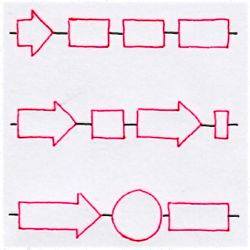Team:UCL/Project
From 2013.igem.org
| (17 intermediate revisions not shown) | |||
| Line 47: | Line 47: | ||
<div class="col_left" style="width:100%;"> | <div class="col_left" style="width:100%;"> | ||
| - | <p class="major_title">INTELLIGENTLY GENETICALLY ENGINEERED MICROGLIA</p> | + | <p class="major_title">IGEM: INTELLIGENTLY GENETICALLY ENGINEERED MICROGLIA</p> |
<p class="minor_title">Synthetic Biology Fights Alzheimer's Disease</p> | <p class="minor_title">Synthetic Biology Fights Alzheimer's Disease</p> | ||
<p class="abstract_text" style="color:#404040;"> | <p class="abstract_text" style="color:#404040;"> | ||
| - | This year, the UCL iGEM team is taking a radical new step with synthetic biology. We intend to explore the potential application genetic engineering techniques on the brain, because it is the site of some of the most subtle, and many of the most devastating | + | This year, the UCL iGEM team is taking a radical new step with synthetic biology. We intend to explore the potential application genetic engineering techniques on the brain, because it is the site of some of the most subtle, and many of the most devastating medical conditions. Alzheimer’s Disease is a neurodegenerative disease characterised by the loss of recent memory and intellectual functions. We have devised a genetic circuit for transfection into microglia, a novel chassis in which standard assembly has never been used, to boost their ability to break down senile plaques, which are associated with Alzheimer’s disease, as well as to support and protect endangered neurons from microglia-mediated neuroinflammation. |
<br><br> | <br><br> | ||
</p> | </p> | ||
| Line 68: | Line 68: | ||
<div class="row_small"> | <div class="row_small"> | ||
| - | <div class="col_illustration" | + | <div class="col_illustration"> |
| - | + | <a href="https://static.igem.org/mediawiki/2013/1/1a/CircuitOverviewMicroglia.gif" data-lightbox="image-1" title="Genetic Circuit Overview in Microglia UCL iGEM 2013"> | |
| + | <img src="https://static.igem.org/mediawiki/2013/1/1a/CircuitOverviewMicroglia.gif"> | ||
| + | </a> | ||
| + | </div> | ||
<div class="col_abstract"> | <div class="col_abstract"> | ||
| - | <a href=" | + | <a href="https://2013.igem.org/Team:UCL/Project/Circuit"> |
<p class="abstract_title">Circuit Overview</p> | <p class="abstract_title">Circuit Overview</p> | ||
<p class="abstract_text"> | <p class="abstract_text"> | ||
| Line 88: | Line 91: | ||
<div class="row_small"> | <div class="row_small"> | ||
| - | <div class="col_illustration" | + | <div class="col_illustration"> |
| - | + | <a href="https://static.igem.org/mediawiki/2013/1/18/Detectionucligem.gif" data-lightbox="image-1" title="Oxidative Stress Promoter for Plaque Detection UCL iGEM 2013"> | |
| + | <img src="https://static.igem.org/mediawiki/2013/1/18/Detectionucligem.gif"> | ||
| + | </a> | ||
| + | </div> | ||
<div class="col_abstract"> | <div class="col_abstract"> | ||
| - | <a href="https://2013.igem.org/Team:UCL/ | + | <a href="https://2013.igem.org/Team:UCL/Project/Detection"> |
<p class="abstract_title">Detection</p> | <p class="abstract_title">Detection</p> | ||
<p class="abstract_text"> | <p class="abstract_text"> | ||
| Line 109: | Line 115: | ||
<div class="row_small"> | <div class="row_small"> | ||
| - | <div class="col_illustration" | + | <div class="col_illustration"> |
| - | + | <a href="https://static.igem.org/mediawiki/2013/5/57/Chemotaxisucligem.gif" data-lightbox="image-1" title="Chemotaxis in Microglia UCL iGEM 2013"> | |
| + | <img src="https://static.igem.org/mediawiki/2013/5/57/Chemotaxisucligem.gif"> | ||
| + | </a> | ||
| + | </div> | ||
<div class="col_abstract"> | <div class="col_abstract"> | ||
| - | <a href="https://2013.igem.org/Team:UCL/ | + | <a href="https://2013.igem.org/Team:UCL/Project/Chemotaxis"> |
| - | <p class="abstract_title"> | + | <p class="abstract_title">Insertion</p> |
<p class="abstract_text"> | <p class="abstract_text"> | ||
| - | + | The brain is an immune privileged organ and the security of the blood brain barrier makes it difficult to get all but the smallest molecules, such as glucose, from the rest of the body into the brain. This makes inserting our genetic circuit into the brain a trickier task than in most synthetic biomedical projects. Here we examine some plausible methods. | |
</p> | </p> | ||
| Line 130: | Line 139: | ||
<div class="row_small"> | <div class="row_small"> | ||
| - | <div class="col_illustration" | + | <div class="col_illustration"> |
| - | + | <a href="https://static.igem.org/mediawiki/2013/4/46/Degradationucligem.gif" data-lightbox="image-1" title="Beta-Amyloid degradation by MMP-9 UCL iGEM 2013"> | |
| + | <img src="https://static.igem.org/mediawiki/2013/4/46/Degradationucligem.gif"> | ||
| + | </a> | ||
| + | </div> | ||
<div class="col_abstract"> | <div class="col_abstract"> | ||
| - | <a href="https://2013.igem.org/Team:UCL/ | + | <a href="https://2013.igem.org/Team:UCL/Project/Degradation"> |
<p class="abstract_title">Degradation</p> | <p class="abstract_title">Degradation</p> | ||
<p class="abstract_text"> | <p class="abstract_text"> | ||
| Line 150: | Line 162: | ||
<div class="row_small"> | <div class="row_small"> | ||
| - | <div class="col_illustration" | + | <div class="col_illustration"> |
| - | + | <a href="https://static.igem.org/mediawiki/2013/8/8a/Selectablemarkerzeocin.gif" data-lightbox="image-1" title="Selectable Marker, Zeocin UCL iGEM 2013"> | |
| + | <img src="https://static.igem.org/mediawiki/2013/8/8a/Selectablemarkerzeocin.gif"> | ||
| + | </a> | ||
| + | </div> | ||
<div class="col_abstract"> | <div class="col_abstract"> | ||
| - | <a href="https://2013.igem.org/Team:UCL/ | + | <a href="https://2013.igem.org/Team:UCL/Project/Marker"> |
<p class="abstract_title">Selectable Marker</p> | <p class="abstract_title">Selectable Marker</p> | ||
<p class="abstract_text"> | <p class="abstract_text"> | ||
We used resistance to zeocin, a cell killing glycoprotein, to act as a selectable marker for transformation/transfection in our chassis; E.coli, HeLa and microglia. | We used resistance to zeocin, a cell killing glycoprotein, to act as a selectable marker for transformation/transfection in our chassis; E.coli, HeLa and microglia. | ||
| + | |||
| + | The biobrick that we made encoding zeocin resistance is a step forward for selectable markers in iGEM - the first one of its kind tailored for mammalian expression systems. | ||
</p> | </p> | ||
| Line 171: | Line 188: | ||
<div class="row_small"> | <div class="row_small"> | ||
| - | <div class="col_illustration" | + | <div class="col_illustration"> |
| - | + | <a href="https://static.igem.org/mediawiki/2013/e/e1/ChassisUCLigem2013.gif" data-lightbox="image-1" title="Chassis: E.coli, HeLa and Microglia UCL iGEM 2013"> | |
| + | <img src="https://static.igem.org/mediawiki/2013/e/e1/ChassisUCLigem2013.gif"> | ||
| + | </a> | ||
| + | </div> | ||
<div class="col_abstract"> | <div class="col_abstract"> | ||
| - | <a href="https://2013.igem.org/Team:UCL/ | + | <a href="https://2013.igem.org/Team:UCL/Project/Chassis"> |
<p class="abstract_title">Chassis</p> | <p class="abstract_title">Chassis</p> | ||
<p class="abstract_text"> | <p class="abstract_text"> | ||
| - | We conducted our experiments in three chassis, creating recombinant plasmids in E.coli before expressing them in HeLa and finally primary and immortalised human microglia lines. | + | We conducted our experiments in three chassis, creating recombinant plasmids in E.coli before expressing them in HeLa and finally primary and immortalised human microglia lines. Human brain cells have not been seen before in an iGEM project, with experiments in microglia coming as son as they arrive! |
</p> | </p> | ||
</a> | </a> | ||
| Line 191: | Line 211: | ||
<div class="row_small"> | <div class="row_small"> | ||
| - | <div class="col_illustration" | + | <div class="col_illustration"> |
| - | + | <a href="https://static.igem.org/mediawiki/2013/d/da/PartsUCligem2013.gif" data-lightbox="image-1" title="BioBrick Parts Submitted to the Registry UCL iGEM 2013"> | |
| + | <img src="https://static.igem.org/mediawiki/2013/d/da/PartsUCligem2013.gif"> | ||
| + | </a> | ||
| + | </div> | ||
<div class="col_abstract"> | <div class="col_abstract"> | ||
| - | <a href="https://2013.igem.org/Team:UCL/ | + | <a href="https://2013.igem.org/Team:UCL/Project/Parts"> |
<p class="abstract_title">Parts</p> | <p class="abstract_title">Parts</p> | ||
<p class="abstract_text"> | <p class="abstract_text"> | ||
| - | We submitted | + | We submitted two parts to the registry; a new eukaryotic and prokaryotic selectable marker, and the protease, MMP-9. |
| Line 213: | Line 236: | ||
<div class="row_small"> | <div class="row_small"> | ||
| - | <div class="col_illustration" | + | <div class="col_illustration"> |
| - | + | <a href="https://static.igem.org/mediawiki/2013/8/8e/FuturedevelopmentsUCLigem2013.gif" data-lightbox="image-1" title="Looking beyond our summer lab work UCL iGEM 2013"> | |
| + | <img src="https://static.igem.org/mediawiki/2013/8/8e/FuturedevelopmentsUCLigem2013.gif"> | ||
| + | </a> | ||
| + | </div> | ||
<div class="col_abstract"> | <div class="col_abstract"> | ||
| - | <a href="https://2013.igem.org/Team:UCL/ | + | <a href="https://2013.igem.org/Team:UCL/Project/Developments"> |
<p class="abstract_title">Future Developments</p> | <p class="abstract_title">Future Developments</p> | ||
<p class="abstract_text"> | <p class="abstract_text"> | ||
| Line 227: | Line 253: | ||
</div> | </div> | ||
| - | |||
| - | |||
| - | |||
| - | |||
<div class="gap"> | <div class="gap"> | ||
| Line 237: | Line 259: | ||
<div class="row_small"> | <div class="row_small"> | ||
| - | <div class="col_illustration" | + | <div class="col_illustration"> |
| - | + | <a href="https://static.igem.org/mediawiki/2013/b/b4/ExperimentsUCLigem2013.gif" data-lightbox="image-1" title="Experiments UCL iGEM 2013"> | |
| + | <img src="https://static.igem.org/mediawiki/2013/b/b4/ExperimentsUCLigem2013.gif"> | ||
| + | </a> | ||
| + | </div> | ||
<div class="col_abstract"> | <div class="col_abstract"> | ||
| - | <a href="https://2013.igem.org/Team:UCL/ | + | <a href="https://2013.igem.org/Team:UCL/Project/Experiments"> |
<p class="abstract_title">Experiments</p> | <p class="abstract_title">Experiments</p> | ||
<p class="abstract_text"> | <p class="abstract_text"> | ||
| - | + | Here we explain the wet-lab experiments that built our project. All of these experiments built the foundation of our project, allowing us to generate, test and subsequently submit biobricks to the registry. | |
| - | + | ||
| + | This section includes experiments for both bacterial and mammalian lab that have been performed before the Lyon jamboree! | ||
| + | </p> | ||
</a> | </a> | ||
</div> | </div> | ||
| Line 257: | Line 284: | ||
<div class="row_small"> | <div class="row_small"> | ||
| - | <div class="col_illustration" | + | <div class="col_illustration"> |
| - | + | <a href="https://static.igem.org/mediawiki/2013/4/4c/Labook_pic.jpg" data-lightbox="image-1" title="Protocols UCL iGEM 2013"> | |
| + | <img src="https://static.igem.org/mediawiki/2013/4/4c/Labook_pic.jpg"> | ||
| + | </a> | ||
| + | </div> | ||
<div class="col_abstract"> | <div class="col_abstract"> | ||
| - | <a href="https://2013.igem.org/Team:UCL/ | + | <a href="https://2013.igem.org/Team:UCL/Project/Protocols"> |
<p class="abstract_title">Lab Protocols</p> | <p class="abstract_title">Lab Protocols</p> | ||
<p class="abstract_text"> | <p class="abstract_text"> | ||
| - | + | You cannot plan an experiment without the procedure. Here we have stored all of the protocols that were used in order to make out wet lab work possible. | |
| + | |||
| + | This section includes protocols for both bacterial and mammalian lab experiments that have been performed before the Lyon jamboree! | ||
</p> | </p> | ||
</a> | </a> | ||
| Line 277: | Line 309: | ||
<div class="row_small"> | <div class="row_small"> | ||
| - | <div class="col_illustration" | + | <div class="col_illustration"> |
| - | + | <a href="https://static.igem.org/mediawiki/2013/b/b6/Silent_safety.jpg" data-lightbox="image-1" title="Safety First UCL iGEM 2013"> | |
| + | <img src="https://static.igem.org/mediawiki/2013/b/b6/Silent_safety.jpg"> | ||
| + | </a> | ||
| + | </div> | ||
<div class="col_abstract"> | <div class="col_abstract"> | ||
| - | <a href="https://2013.igem.org/Team:UCL/ | + | <a href="https://2013.igem.org/Team:UCL/Project/Safety"> |
<p class="abstract_title">Safety</p> | <p class="abstract_title">Safety</p> | ||
<p class="abstract_text"> | <p class="abstract_text"> | ||
Latest revision as of 03:22, 5 October 2013
IGEM: INTELLIGENTLY GENETICALLY ENGINEERED MICROGLIA
Synthetic Biology Fights Alzheimer's Disease
This year, the UCL iGEM team is taking a radical new step with synthetic biology. We intend to explore the potential application genetic engineering techniques on the brain, because it is the site of some of the most subtle, and many of the most devastating medical conditions. Alzheimer’s Disease is a neurodegenerative disease characterised by the loss of recent memory and intellectual functions. We have devised a genetic circuit for transfection into microglia, a novel chassis in which standard assembly has never been used, to boost their ability to break down senile plaques, which are associated with Alzheimer’s disease, as well as to support and protect endangered neurons from microglia-mediated neuroinflammation.
Click the abstracts below to read more.
 "
"










